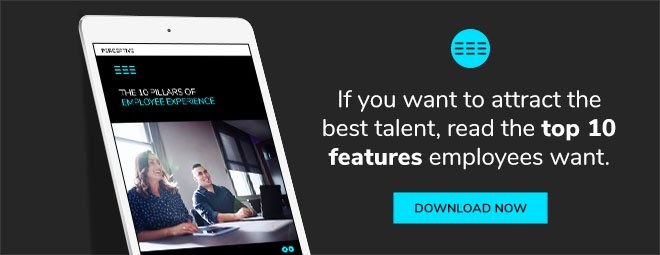Workplaces and employees have undergone radical change in the last few years—from the pandemic to new ways of working, adapting to new digital transformation technologies and navigating the Big Quit. As a result, employee engagement has shot up the list of priorities for businesses—particularly when it comes to retaining staff.
However, the benefits of engaged employees don’t stop at retention, businesses with highly engaged employees are 21 per cent more profitable and experience 41 per cent lower absenteeism, higher morale, higher productivity, and better customer service.[1]
But how does a business achieve high employee engagement? And more to the point, how do they sustain it?
The answer lies in regularly measuring and tracking key employee engagement KPIs—and taking action on those that are lagging. With that in mind, these are the critical KPIs you should be assessing.

Free guide: The 10 Pillars Of Employee Experience
1. Role clarity
By clearly defining each employee’s role and making your expectations clear, your staff know what they need to do to be successful at their job. Moving goalposts and forcing employees to guess what you want can lead to stress, uncertainty and reduce confidence in their skills—all of which is hugely damaging to their overall engagement.
Employees who know what they need to do to succeed are more likely to be motivated, better able to prioritise tasks, meet deadlines, manage their workload, and avoid getting tied up in tasks that are not part of their role.
2. Support
A 2022 study of 5,500 workers from around the world found 52 per cent of workers stayed in a job because they felt valued and supported. Support can take a range of forms, from ensuring your staff have the right tools for the job and enough hands on deck to do the work, to the right training to succeed in their role, coaching leadership style, regularly checking in on how staff are faring, helping them troubleshoot/problem solve, and providing clear instructions. Employees who are well supported are more likely to be efficient, high performing and highly motivated.
Without support, you risk leaving your employees feeling isolated, uncertain, and unconfident in their abilities. In the case of being understaffed or not having the right equipment, employee frustration, stress and anger will rise—which will not only affect the individual but your overall workplace culture.
Important note: don’t introduce new tools for the sake of new tools. Ask what that new piece of technology or software is improving and whether it has made a difference. New technology should enhance your employees’ experience, not make it worse.
3. Efficient systems and processes
Unclear, bureaucratic and overly tedious processes can increase stress, confusion, and may lead to employees cutting corners to get through the red tape—which can have disastrous, costly, and sometimes deadly consequences. According to Dana Deibel, owner of the management consulting firm EverRamp, employees are most likely to cut corners when the ‘what’ and ‘why’ of their work is not communicated. With this in mind, it is essential that businesses explain why certain processes need to be followed or systems used, for example, to maintain industry accreditation, for audit reasons, insurance purposes, or occupational health and safety. Make sure your processes and systems are well documented, clear and easy to understand, and accessible to every employee should they need to refer to them.
Getting a measure of whether your employees think your business’s systems and processes are efficient will help you gauge whether certain systems or processes are hamstringing your team(s) performance. Uncovering and addressing inefficient processes and systems also helps minimise the chance of employees cutting corners out of frustration or because they think they’ve found a better way.
4. Motivation
Motivated employees are engaged employees, making them more productive, efficient, and high performing. Moreover, they are willing to dig deep and go above and beyond to deliver products and services they are proud of—professional pride if you will. In short, they care about the work they are doing and want to do a good job. As a business, motivated employees also paves the way for excellent customer service, internal service, and quality of work.
5. Interesting and challenging work
Interesting work makes for engaging work, which in turn makes for engaged employees and higher job satisfaction. With 1 in 3 professionals citing boredom as the main reason for leaving their jobs in 2018, providing interesting work will help you keep your staff longer. Assessing how interesting or challenging your employees find their tasks is a good way to understand whether the work you’re offering them is stimulating enough. If it’s not, potentially look to increase training and development opportunities to re-engage staff who are losing interest.
6. Recognition
As a manager, recognising your team—together and individually—is critical. It shows employees their work matters. Moreover, it also shows that you and your business leadership appreciate their efforts, giving them a sense that they’re contributing, are making a difference, and that their work is meaningful.
Recognising your employees shouldn’t be reserved until their annual review—it needs to be regular and consistent. Research has found that 43 per cent of highly engaged workers receive feedback at least once a week. Meanwhile, 77 per cent of employees would agree to work harder if they were receiving more recognition. Unfortunately, 41 per cent of employees don’t feel valued at work, meaning there’s room for improvement here—even a few simple words such as “great work” can give an employee a morale and motivation boost.
The pandemic has further exasperated labour shortages—both in New Zealand, Australia and around the world. As a result, many workers have had to put in extra unpaid hours or take on responsibilities they wouldn’t usually manage. A global study found, 70 per cent of staff have had to take on more responsibilities without extra pay or promotion and 69 per cent have had to work longer hours. Going forward it is important that businesses acknowledge, recognise, and compensate workers who have put in the hard yards during this time.
7. Stress
According to Gallup, 45 per cent of New Zealanders and Australians experience a lot of stress on a daily basis—higher than the global average of 43 per cent. While short-term moderate stress can be a good motivator and encourage high performance, long periods of high stress can have the opposite effect. Constantly, high-stressed employees are more likely to feel overwhelmed, distracted and emotionally vulnerable. In severe situations, it can have serious impacts on their physical and mental well-being, causing conditions such as burnout, numerous chronic illnesses, high blood pressure, headaches, and digestion issues, all of which can cause performance to drop and absenteeism and presenteeism to rise.
With this in mind, it’s important to get a measure of your employees’ stress levels, understand the reasons behind them, and take actions accordingly to alleviate situations that are causing high, long-term stress in your organisation.
8. Work-life balance
A 2022 study found that work-life balance was the number one reason why people stayed in their jobs over the last year. Employees want work-life balance and 87 per cent expect their employer to support them in balancing work and personal commitments. If your workers feel like that balance is shifted heavily towards the work side of the scale, you could see higher staff churn. For this reason, businesses need to understand how employees perceive their work-life balance and whether their work demands are putting them at risk of leaving.
9. Employee voice
Being able to share opinions at work without fear of rejection is essential to workplace performance; it builds trust, collaboration, team skills, and encourages new innovative ideas that improve and grow a business. However, a startling 50 per cent of employees keep quiet at work, particularly when it involves speaking to someone above them in their workplace hierarchy.
A culture of silence can be dangerous—and costly. Companies with a culture of silence are more likely to exhibit unethical practices, errors, safety issues and inefficacies. Instead of speaking out, employees fear being publicly reprimanded, being labelled as a troublemaker or non-team player, or damaging their career and professional relationships. Employees may also believe that if they do speak out, their voice will be ignored.
Research has found that the best way to get employers to listen and act on employee voice is with high-quality ideas/opinions. These are ideas/opinions that are:
- Backed by logic and evidence.
- Are practical and realistically possible to implement.
- Benefits the organisation and aligns with its vision, mission and goals.
- Innovative and untried previously.
As an employer, it is important to encourage staff to consider these four points when they bring an idea/opinion forward. Asking questions such as “what is the logic behind this?” and “what evidence supports it?” or “is this realistically feasible?” are an excellent way to get employees thinking more strategically and developing high-quality employee voice.
10. Company values
A 2018 study found that 24 per cent of employees who were looking for a new job did so because their current organisation’s culture doesn’t fit them or their values. While there could be several reasons for this, it often boils down to an organisation’s leadership and staff were not honouring or exhibiting the company’s values.
If your business has gone to the effort of creating company values, it is essential that the day-to-day actions of your organisation’s leadership reflect them. Moreover, those values play a crucial role in attracting talent, and if you’re simply paying lip service to those values, chances are you won’t have them around for long.

11. Contribution and meaningful work
Employees who feel their jobs are meaningful are 55 per cent more motivated, 43 per cent more loyal, and 20 per cent more productive. Moreover, they’re also significantly less likely to quit and are absent less. One of the key ways to help employees feel their work has meaning is to show how their efforts contribute to the business’s success—and recognising them for it.
12. Trust
Globally, businesses are doing well when it comes to eliciting trust from their staff with 76 per cent of employees trusting their employer in 2021. This number is only going up due to the erosion of trust in government and the media over the pandemic. As a result, people are turning to their employers instead—and their expectations are high.
The good news is that trust in managers and business leadership increases motivation and performance. It also encourages employees to look after each other’s well-being. What’s more, research has found that training managers on empathy, integrity, and trustworthiness correlates to a significant increase in productivity. In terms of retention, trust makes employees more loyal and positive—the first being good for your business, the second being good for your employees’ wellbeing and overall workplace culture.
13. Career progression/growth
Career progression was the number one reason why workers left their job according to a 2022 global study. Having opportunities for career growth and a map of progression is hugely motivating for employees, providing them direction and a goal to strive for. It is also very good for their overall well-being; the link between high career well-being and overall well-being is well documented. Setting career progression goals are also a great way to boost motivation.
Assessing whether you are offering enough in the way of career growth and progression is a good way to measure staff loyalty and retention, particularly among Gen Z’s, who are expected to have between 16 to 18 jobs in their lifetime and Millennials, who have a slightly lower figure of 12 to 14 jobs within their lifetime. With job switching to advance their career now the norm, if you’re not offering growth you’ll likely see your top talent moving on.
14. Learning/professional development
Similar to career progression, providing learning opportunities not only keeps staff interested and engaged, but also builds their efficiency, expertise and confidence—all of which increases their value to your business, improves their service to your customers and keeps them engaged. Moreover, providing learning and training opportunities reduces stress when needing to learn new tasks or take on new responsibilities and makes staff feel supported.
Again, much like career progression, if staff feel like they are not learning or developing their skills, they are more likely to disengage with their work and ultimately look for new challenges somewhere else.
Learn the 10 critical elements that attract and retain talent, build a positive workplace culture, and keep your employees engaged in our free guide: The 10 Pillars Of Employee Experience.
[1] Harter J. and Mann A. 'The Right Culture: Not Just About Employee Satisfaction', Gallup.com. Published April 12, 2017. Available at: https://www.gallup.com/workplace/236366/right-culture-not-employee-satisfaction.aspx
